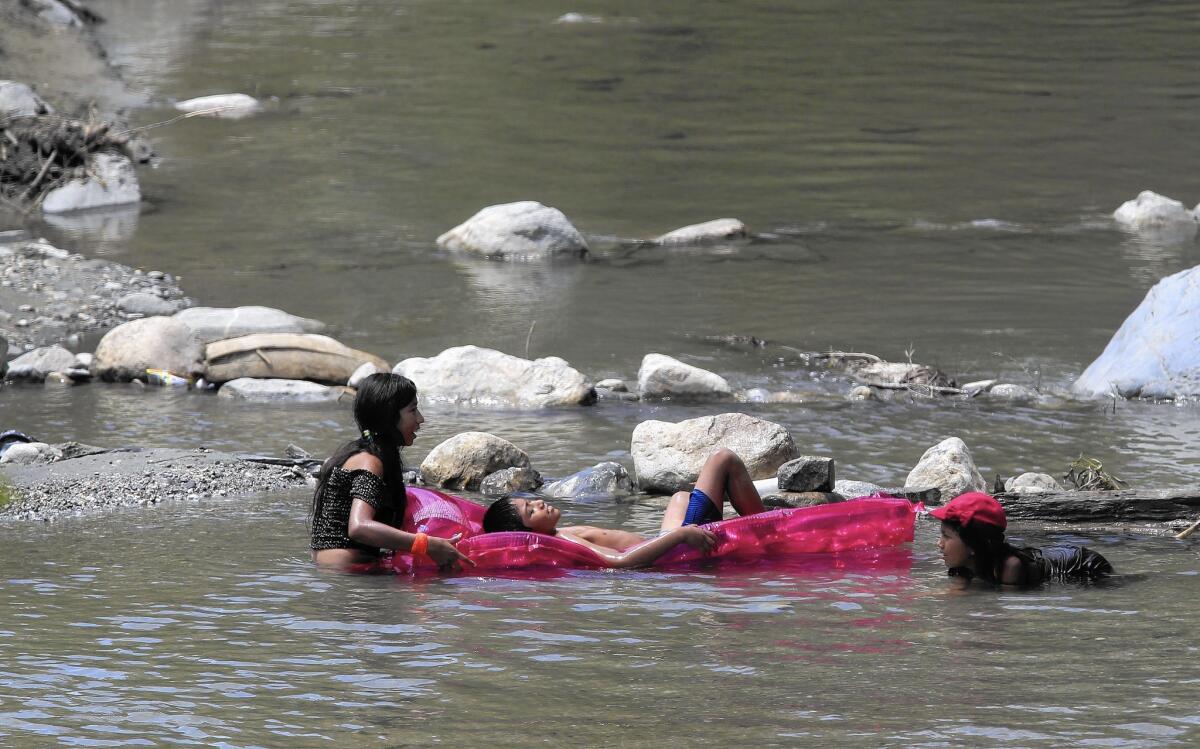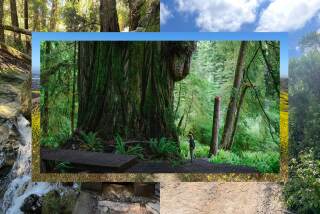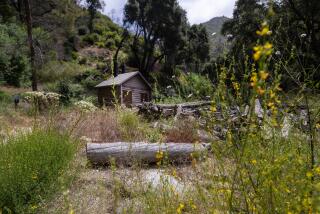In the San Gabriel Mountains, they’re asking: What monument?

Visitors to the San Gabriel Mountains can be forgiven if they see overflowing trash bins, broken marijuana pipes, graffiti and road kill and wonder what became of President Obama’s vision for the wilderness.
Nearly a year after he upgraded Southern California’s mountainous backyard to national monument status, with a promise of a cleaner and safer wilderness, little has changed.
Last week, Abby McCrea, 34, a marriage and family therapist who rides her bike in the mountains at least once a month, looked at the surrounding landscape and wondered aloud, “New monument? Where is it?”
Trash, broken beer bottles and other blight were present in abundance. Porta Potties and interpretive signs were covered by graffiti. Ravens pecked at dead snakes and squirrels that had been run over by drivers along a two-lane road.
The only obvious indication of the historic designation was a sign, barely visible in the shade of six pine trees along California 39 just north of Azusa, that read: “San Gabriel Mountains National Monument.”
Activists and elected officials who lobbied for monument status say they are disappointed that no new federal revenue is flowing to the mountains. Fundraising by nonprofit groups has slowed, and the U.S. Forest Service said it does not plan to significantly change the way it manages the 346,000-acre wilderness.
In an interview, Jeffrey Vail, superintendent of the monument, urged patience during its start-up period. Although the monument does not have a budget of its own, Vail said he managed to procure $3 million from other federal sources that is being used to help pay for California Conservation Corps work crews and to hire additional staff, including half a dozen “field ambassadors” to patrol tourist hot spots.
“Sometimes there’s a misperception in terms of how long it takes before a new national monument can be fully formed,” he said. “We need to be somewhat realistic about creating a management plan that is in line with contributions.”
Significant improvements under discussion include public transportation systems in the monument, which stretches from peaks north of the city of Rancho Cucamonga west to rugged areas above the city of Santa Clarita. About 4,000 acres are within the neighboring San Bernardino National Forest.
Activists and others say those steps do not address a more fundamental problem. The proclamation Obama signed in October did not require the monument to be a new administrative unit, leaving the existing authority of the Forest Service in place.
A recent Forest Service analysis concluded that the wilderness, within an hour’s drive for 10 million people, does not need a separate management plan or an environmental impact study of the landscape’s treasures: historic artifacts, streams that recharge the metropolitan aquifer in the flatlands below, and habitat for rare and endangered species, including the Nelson’s bighorn sheep and mountain yellow-legged frogs.
The analysis said that standards established in its 2005 management plan for the four Southern California forests under its jurisdiction are sufficient to protect the monument, which encompasses about half of the Angeles National Forest.
In formal responses submitted last week, community and conservation organizations said the plan undermines the primary reason they supported establishment of the monument: Existing management policies do not adequately address the region’s problems.
“It seems the Forest Service wants to treat the monument no differently than any other part of the national forest,” said Steve Evans, a legislative consultant for the nonprofit California Wilderness Coalition.
Critics also are disappointed that the proposal does not allow public engagement with the budget process. Some worried that it could discourage prospective donors.
In October, the National Forest Foundation, a nonprofit funding arm of the Forest Service, established a special fund with a goal of raising $3 million to accelerate high-priority restoration projects in the monument. So far, the foundation, which sweetened the pot with a $2.1-million donation of its own, has raised an additional $800,000 from other sources.
“A lot of people are beginning to wonder if the designation of the monument was a largely a ceremonial act,” said Tim Brick, managing director of the nonprofit Arroyo Seco Foundation.
Belinda Faustinos, chairwoman of San Gabriel Mountains Forever, said her group is trying to round up enough volunteers and donations to clean public restrooms, pick up litter and decorate trash cans.
Mark Yelton, owner of the Camp Williams & General Store along the east fork, said he also “would love to see this area thrive.”
“But right now,” he said, “when a visitor asks, ‘What’s changed?’ I say, ‘There’s a new sign at the bottom of the mountain. That’s about it.’ ”
Twitter: @louissahagun
ALSO:
Exide cleanup: Toxic lead removal could be California’s biggest yet
Brush fire near San Luis Obispo grows to 2,000 acres as firefighters gain on 3 other blazes
Man arrested after hidden camera found in a Starbucks restroom in Orange County







